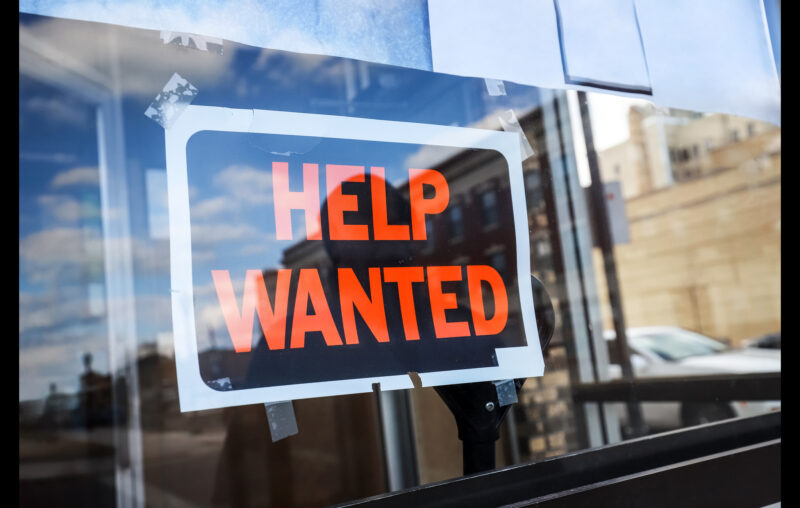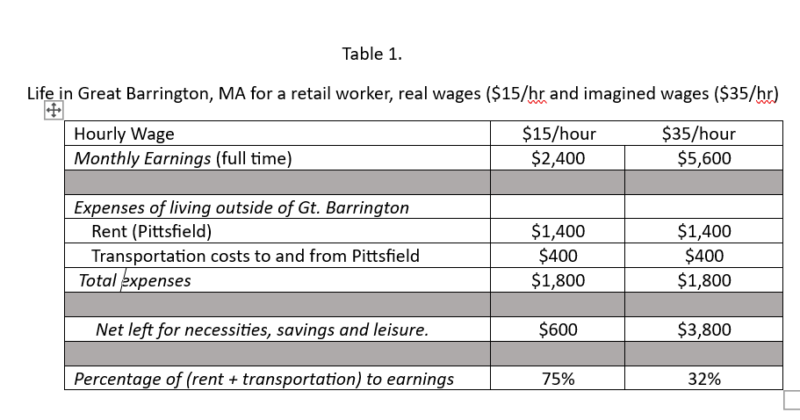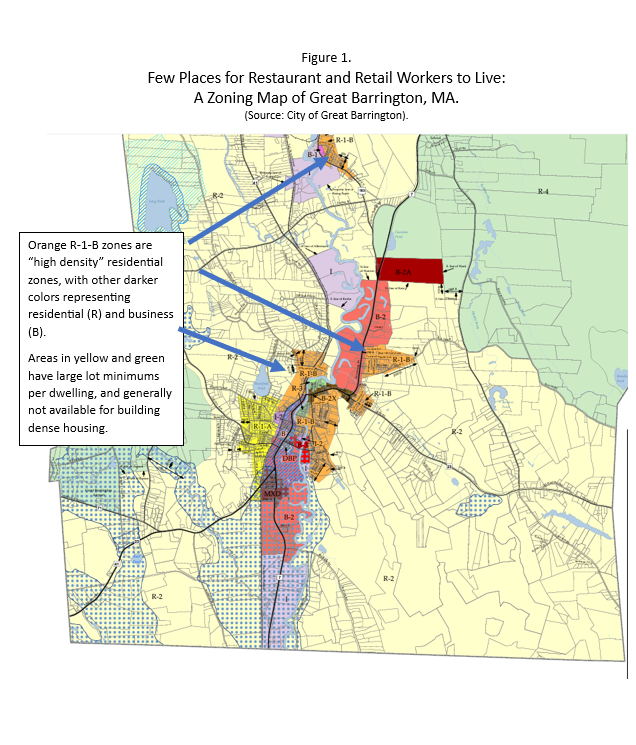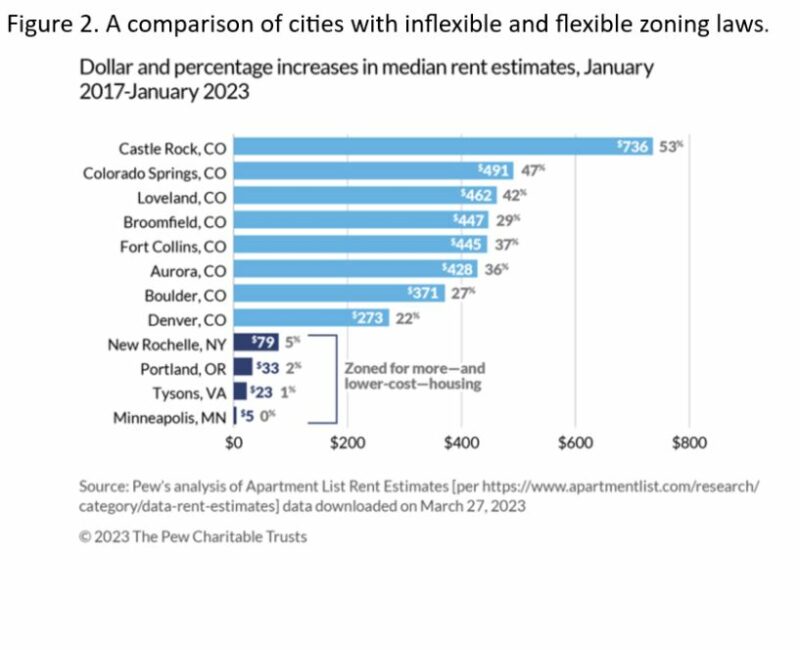Where Have All the Workers Gone? Zoning and Its Unintended Consequences.

Great Barrington, Massachusetts is a bucolic town in the beautiful Berkshires, and the home for the American Institute for Economic Research. During my recent visit this June, a group of us ventured out for a meal downtown on a Wednesday evening. To our surprise, it was nearly impossible to find an open restaurant to enjoy a sit-down meal. An Indian restaurant had closed its indoor seating and was takeout only. Another place was only open 4 days of the week, while a third establishment had restricted hours. We noticed other groups like us on foot, wandering from place to place, only to find one darkened storefront after another. “Staff needed” signs are hung not only outside restaurants, but also at the assortment of trendy downtown retail shops.
Great Barrington is not an isolated example, and I’ve noticed small, tourist-oriented towns throughout the country have similar “help wanted” signs. In my visit to Hot Springs, North Carolina a few months ago, two restaurants were sharing some of the same wait staff. The first place was only open Sunday through Wednesday, while the second was only open Thursday-Saturday. In conversations with the managers, they all told us the same thing: “We can’t get people to work for us.” The same thing to happened to us in the popular town of Bar Harbor, Maine last summer.
Great Barrington, Massachusetts has a shortage of workers that makes it challenging to staff its shops and restaurants, like many areas across the U.S.
Where have all the workers gone? Our economics textbooks tell us where there is a shortage, price rises accordingly, bringing needed resources to the market. There was a shortage of eggs a few months ago and prices rose, which spurred farmers to breed more chickens. Egg prices are now back to a reasonable level.
But more than a year after COVID lockdowns ended, there are still ongoing shortages of labor all over the country, especially in these types of towns. Unlike the chickens, the workers aren’t arriving to fill the void. Some would say this is just an example of a broken labor market, a result of greed from business owners who won’t raise wages. Here’s an early spoiler alert: When we observe a “broken market,” there is usually a government intervention causing a disruption, often hidden well beneath the surface and causing unplanned ripple effects to other places.
Let’s do some more detective work to delve deeper into the local labor market. We’ll use a hypothetical case of Cathy, who would love to move to Great Barrington and work in a downtown restaurant or retail shop. On a recent internet search to find an apartment for her, I saw there were zero apartments available in the Great Barrington area. The nearest place I could find was an aging apartment in Lee, MA, about a 25-minute drive away. The relative convenience of living in Lee versus farther away places doesn’t come cheap- this particular place rents for $1,350 a month.
Suppose Cathy extended her search to the larger and slightly grittier town of Pittsfield, which is a common place for people to live who work in Great Barrington and the other tourist towns in the area. A modern, well-appointed 1-bedroom apartment will cost around $1,450, but she’ll now face a 45-minute drive each way to Great Barrington. If she gets a job in Great Barrington at $15 an hour working full-time, in a month she’ll earn $2,400. That leaves $950, but she’ll conservatively spend $400 more a week on transportation to Great Barrington and back, including maintenance and depreciation.
That doesn’t include her lost time, in this case around 30 hours per month spent commuting between Pittsfield and Great Barrington. If evaluated at her $15 hourly wage, that lost time costs her an additional $450 a month.
Table 1 below measures Cathy’s direct costs, leaving aside her time costs. She is left with just $600 to manage her food, utilities, clothes, leisure activities like Netflix, and savings. Her housing plus extra transportation for work costs around 75 percent of her monthly budget. As we can see, for the majority of potential workers, the cost of working in town would exceed the benefit, unless they split housing costs by finding a roommate.
How high would wages need to go? Most finance professionals will tell us that spending no more than a third of one’s salary on rent and commute costs is prudent, leaving the rest for necessities, leisure activities and saving for the future. But to satisfy that goal, the ordinary retail worker would need to earn $35 an hour or $5,600 a month, leading to $67,200 a year, as Table 1 shows.

So why aren’t wages rising accordingly?
Restaurants spend about a third of their revenue on labor costs. If labor costs went up from $15 an hour, to say, $30 an hour, that’s a 100 percent increase.
Take the example of a $15 hamburger at a local restaurant, where a third of the revenue typically goes to pay the staff making the burger, or $5. (Note: another third of revenue typically goes to food costs, and the remaining third is overhead and profit). If wages doubled, the price of the burger would need to go up to $20. And now half of all restaurant revenue would be going to labor, rather than a third. That could put a further crimp in owners’ profits, as the net profit margin in restaurants and retail averages around 3- 5 percent.
We can see that the restaurants are now caught in a bind. If they raise wages, they will lose customers and revenue through higher menu prices. The only thing left is to ration restaurant days and hours open, in an attempt to deal with the hand they’ve been dealt, an ongoing shortage of labor.
That leaves a seemingly obvious option to solve this dilemma: figure out how to lower the cost of housing through building inexpensive apartments, so people like Cathy don’t have to travel so far. But an “obvious” solution like building apartments will cause a conflict between current homeowners and future residents, especially in bucolic settings with tourist towns. Unfortunately, the chosen policy solution to this conflict has created ripple effects that end up with these types of broken labor markets.
These conflicts are invisible to the casual observer. As one drives through Great Barrington and other quaint towns across New England, we admire their historic quality, the homes with white picket fences, and the open countryside with sheep and cows peacefully grazing. As Robert Ellickson notes in his 2022 book America’s Frozen Neighborhoods: The Abuse of Zoning , studies show that homeowners are “socially embedded” in their neighborhoods and usually value their homes at greater than the market value. Any change in the environment disrupts the homeowner’s expectations about the neighborhood’s amenities and characteristics, as well as the effect on property value. For many people, the equity in their house is the single largest component of their accumulated wealth.
Indeed, large apartment complexes are few and far between in the Berkshires, even though there is an underlying demand by workers and business owners for more inexpensive housing. No doubt the complexes would be seen as “ugly” by many of the locals, intent on preserving the area’s pristine beauty and controlling traffic. But as we know, there is a cost to everything, including beauty. This cost surfaces as an unintended consequence of using regulation as a tool to control the type of housing stock. In cities run by residents intent on preserving the beauty of the environment, an unintended outcome is discrimination by social class. Those who work in town are far less able to enjoy its many delights as a resident, since they likely live almost an hour away.
Economist George Stigler and others transformed the economics profession by thinking about regulation not as a benign rule but arising from a demand-supply framework. A demand for a regulation was met by a supply of regulation, which helped inspire the Public Choice school of economics. One consistent theme of the Public Choice school is that a regulation meant to solve one problem ends up unexpectedly creating another, which is sometimes called “the law of unintended consequences.”
We see this theory in action to explain what is happening to the price of land and how it connects to local labor markets. Tight zoning restrictions have been supplied throughout the Berkshires and many other tourist areas in order to satisfy the residents’ demand to retain its rural charm. In Great Barrington, the city has supplied this demand with a long list of zoning bylaws which require special permits that can extend construction times for months, if not years.
These bylaws create unintended consequences that ripple into labor markets and constrain the shopping and dining options for Great Barrington’s residents and visitors. Yet I would guess that few people make this connection. Instead, the perceived villains that have caused the problems are “rich New Yorkers buying up local property” or “greedy landlords,” or “profit-hungry business owners.”
Below is a zoning map for Great Barrington taken from the city website. The areas where workers might live near the downtown appear like a narrow peninsula is a sea of pastures. The approved residential zones for the town are labeled R1-A, R1-B, R2, R3 and R4. The zoned area of R1-B is the only area that allows for higher density housing. It is rare for lower density zones to be changed to higher density zones anywhere in the U.S. The green and yellow areas are zoned for rural uses. The end result is that the zoning laws squeeze out opportunities for lower-income workers to enjoy the same beauty and experiences of living in small-towns like Great Barrington. Instead, they must spend up to 2 hours a day commuting from far-away towns, taking away from their quality of life.

Around the country, research by the Pew Charitable Trust finds that the experience of Great Barrington is mirrored by other cities, large and small. Jurisdictions that have more relaxed and flexible zoning laws are keeping rent in check. For example, Castle Rock, Colorado Springs, Fort Collins and Boulder saw rent increases between 27-53 percent between 2017-2023 and have allowed very little housing to be built. In contrast, cities like New Rochelle with more relaxed zoning laws have enjoyed far smaller rent increases in the single digits, as Figure 2 shows.

In addition, environmental regulations that restrict the supply of land will lead to an increase in the price of land. Regulations such as the Endangered Species Act, wetlands regulations, and coastal zone management laws may have desirable end goals from one point of view, but invariably make housing more expensive.
As the economist Frederic Bastiat once wrote, there is the seen and the unseen in life, and economics can help us reveal the unseen. When we look to solve puzzles in the market around us, taking a closer look at unintended consequences of government regulations is an excellent place to start.










